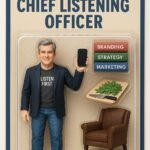In the glittering world of Hollywood, where dreams are spun into blockbusters, and in the sleek boardrooms of Fortune 500 companies, where brands become legends, one element reigns supreme: storytelling.
As a seasoned storyteller who has shaped narratives for brands and companies, I can assure you that your brand’s story is not just a nice-to-have—it’s your most powerful asset.
And if almost everyone on your team can’t tell your brand’s story, your brand will have difficulty getting amplified in the marketplace.
The most common refrain I hear when I ask CEOs, to tell me about their business, is that they share features about their products and services, and lack a succinct story. They go on and on and on and on. At the end of their boring monologue, they tell me their difference is their people.
Excuse my French but that’s crap. That’s table stakes today, not a point of difference.
Not having a succinct story is brand malpractice.
Why Your Brand’s Story Matters
Every great film begins with a compelling script, and every iconic brand starts with a captivating story. Your story isn’t just what you do; it’s why you do it. It’s the heartbeat of your organization, the north star that guides every decision, and the magnet that attracts loyal customers.
In today’s hyper-connected world, consumers crave authenticity. And attention is the most valuable commodity.
Consumers don’t just buy products; they invest in narratives that align with their needs, interests, and beliefs. Your story transforms your offering from a commodity into a symbol of shared values and aspirations.
Crafting Your Brand’s Epic Tale
Find Your Origin Story: Every superhero has one, and so should your brand. Was it a problem you faced? A vision you couldn’t shake. Dig deep into why you started. Apple’s saga begins in a garage, where two Steves (Jobs and Wozniak) set out to democratize computing. That humble origin still resonates today.
Identify Your Hero’s Journey: In Hollywood, the hero faces trials, learns lessons, and emerges transformed. What challenges have you overcome? Tesla’s Elon Musk isn’t just selling electric cars; he’s on a quest to save the planet from climate change, battling oil giants and skeptics. And part of his story is built on being a tech company, not a car company. Note: In the last five year
Define Your Antagonist: Every great story has a villain. For your brand, it’s the problem you’re solving. TOMS Shoes fights against poverty, making every purchase a blow against their antagonist.
Highlight Your Unique Magic: v. For your brand, it’s your unique value proposition. What do you offer that no one else can? Airbnb’s magic isn’t just accommodation; it’s the power to “belong anywhere.” Through your work, what value do you bring to a problem customers have? AirBnB solves a problem for travelers.
Showcase Your Supporting Cast: Great movies have memorable side characters. Your brand story includes your team, partners, and customers. Spotlight their tales. Patagonia often features stories of environmental activists aligning their brand with these modern-day heroes.
Craft Your Story Arc: Like any blockbuster, your story needs structure—a beginning (your origin), a middle (your challenges), and an end (your vision). But in branding, the “end” is ongoing. It’s where you’re heading. Amazon’s Jeff Bezos started with books but always envisioned “Earth’s most customer-centric company.”
Making Every Team Member a Storyteller
In Hollywood, everyone from the director to the gaffer understands the story they’re telling. Similarly, every team member should be a brand storyteller.
1. Create a Story Bible: In TV, this document outlines characters, arcs, and themes. Create one for your brand. Include your mission, values, critical narratives, and brand voice. This ensures consistency, whether someone’s in sales or support.
2. Host Story Workshops: Just as actors do table reads, gather your team to dissect your brand’s story. Discuss pivotal “scenes,” understand character motivations, and practice dialogues (customer interactions).
3. Use Internal “Dailies: In film, dailies are raw footage viewed by the crew to stay aligned. Share weekly story snippets—a customer triumph, a team achievement—to keep your narrative alive internally.
4. Encourage Personal Chapters: Each team member should find their place in your story. At Zappos, famous for its culture, employees are encouraged to express how they uniquely contribute to the “deliver happiness” narrative.
5. Celebrate Storytelling Heroes: The Oscars honor the best in Hollywood. Create awards for team members who exceptionally embody and share your brand story, incentivizing others.
Eleven Real-World Brand Stories that Captivate – Learn from Other Great Brands
Warby Parker: Their tale begins with a lost pair of glasses during a backpacking trip, making one founder rely on his limited student budget for the entire first semester. The antagonist? Overpriced eyewear. Their magic? Designer glasses at revolutionary prices, plus a buy-one-give-one model. Every purchase continues its story of vision, both literally and figuratively.
Patagonia: It was founded by a passionate climber, Yvon Chouinard, who began by forging his own climbing tools. As his equipment gained popularity, he faced a dilemma: his pitons were damaging the very cliffs he adored. Instead of profit, he chose preservation. Today, every Patagonia product tells this ongoing story—a brand willing to sacrifice for its environmental beliefs.
Glossier: Emily Weiss’s journey from fashion intern to beauty blogger to CEO is a digital-age Cinderella story. Frustrated by the industry’s top-down approach, she turned to her blog’s community, co-creating products with real women. Glossier’s tale is empowering, where every customer is a protagonist, shaping beauty standards together.
Lego: In 1940s Denmark, Ole Kirk Christiansen, a carpenter, crafted wooden toys during wartime scarcity. His adversary? Children’s dimming imagination in dark times. His invention? Interlocking plastic bricks, offering infinite creative possibilities. Lego’s chronicle is one of resilience, where every brick represents a fragment of joy, allowing children to construct worlds far brighter than their realities.
Tesla: Elon Musk’s electric dream was born from a love for fast cars and a loathing for fossil fuels. His archenemies? Oil barons and automotive giants, dismissing electric vehicles as glorified golf carts. His wizardry? Transforming electric cars from eco-compromises to objects of desire. Tesla’s saga is a tech-driven rebellion, each vehicle a mobile manifesto, silently speeding toward a future unchained from the gas pump.
Spotify: In 2002, Daniel Ek witnessed music’s dark age—piracy rampant, artists unpaid. The villain? An industry clinging to outdated models, driving fans to illegal downloads. His spell? A platform offering millions of songs for the price of a CD. Spotify’s tale is a digital-age harmony, where algorithms act as personal DJs, and each stream contributes a note to the symphony of fair compensation, recomposing the music world’s future.
TOMS: Blake Mycoskie’s Argentine adventure revealed a harsh reality—children without shoes, vulnerable to injury and disease. The villain? Poverty’s cyclical nature. His heroic notion: for every pair sold, another is given away. TOMS doesn’t just sell shoes; it sells steps toward a better future. Each purchase is a chapter in an ongoing global narrative, where compassion walks hand in hand with commerce.
Airbnb: In 2007, design conference attendees overwhelmed San Francisco’s hotels. Joe Gebbia and Brian Chesky saw opportunity in their air mattresses. The antagonist? The impersonal hotel industry. Their spell? Transforming strangers into hosts, living rooms into gateways. Airbnb’s saga is one of trust, turning the world into a patchwork quilt of homes, each square a unique story waiting to host your own.
Beyond Meat: Ethan Brown grew up on a farm, grappling with a paradox—his love for animals versus their fate on his plate. His nemesis? The meat industry’s environmental toll. His innovation? Plant-based proteins that sizzle, bleed, and satisfy like meat. Beyond Meat’s epic is one of alchemy, transmuting peas and beets into a solution for our planet’s health, one burger at a time.
Allbirds: Tim Brown, a New Zealand soccer player, was bewildered by the synthetic chaos in his shoe closet. His nemesis? The footwear industry’s addiction to logos, neon, and plastic. His mythical material? Merino wool, soft yet sturdy, from his homeland’s sheep. Allbirds’ fable is one of simplicity—shoes stripped bare, reflecting nature’s elegance. Each pair whispers a quiet rebellion against flashy excess, inviting wearers to tread gently on our fragile Earth.
Oatly: In the 1990s, Swedish scientist Rickard Öste sought a solution for lactose intolerance. His unexpected foe? Cultural resistance—milk’s reign seemed unshakeable. His alchemical feat? Transforming humble oats into a creamy, nutritious milk alternative. Oatly’s narrative is a cheeky insurgence, its cartons brandishing wit (“It’s like milk, but made for humans”) to challenge dairy’s throne. Every sip continues this modern David vs. Goliath tale, where a grain dares to redefine a dietary staple.
Your Story, Your Legacy
In the annals of cinema, certain films transcend entertainment to shape culture. In the business world, some brands rise above commerce to redefine industries. The difference? A story so powerful it echoes through time.
Your brand’s story isn’t just a marketing tactic; it’s your legacy.
Craft it with the passion of a Hollywood visionary, share it with the conviction of a C-suite leader, and watch as it transforms not just your bottom line but the very world in which you operate.
In this grand theater of commerce, what tale will you tell?
You have eight seconds.
Go!
Connect with Jeff at The Marketing Sage Consultancy. Interested in setting up a call with me? Use my calendly to schedule a time to talk. The call is free, and we can discuss your brand and marketing needs. If you want to learn more about my new offering, The Trusted Advisor Board, you can click here to learn the details. Feel free to email me at jeffslater@themarketing sage.com or text 919 720 0995. Thanks for your interest in working with The Marketing Sage Consultancy.

Photo by Hassan Khan on Unsplash





Great article and a good reminder to make sure everyone on the team is telling the same story.
Thanks, Kris. Motivation comes from alignment, and stories help to bring together communities. Religions have been doing this for thousands of years.